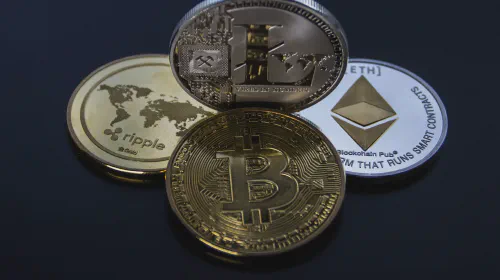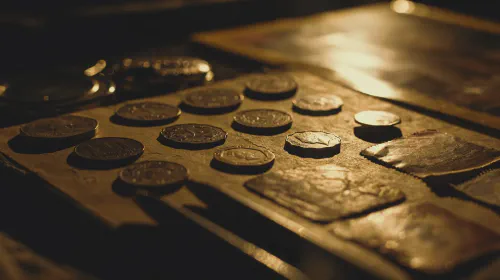Cardano Tokens: Total Issued and Circulating vs. Bitcoin's Limited Supply
Salomon Kisters
Aug 30, 2022This post may contain affiliate links. If you use these links to buy something we may earn a commission. Thanks!
Many cryptocurrencies are issued with a fixed amount of tokens. The list of cryptocurrencies with a fixed market cap includes the original bitcoin (BTC) that was launched in 2009, with a total of 21 million Bitcoins.
There are some explanations for a digital currency capped with a fixed number of tokens, such as demand and supply controls or mathematical limitations. That does not necessarily mean they are better or worse than unlimited cryptocurrencies.
The value of a currency depends on many other factors that can affect its token price, most notably investor confidence in the project and the performance of the blockchain it resides within.
In this article, we will take a look at Cardano, which is a cryptocurrency that has a limited supply, and see how many Cardano tokens are there and how many are left.
What is Cardano?
Cardano is a third-generation blockchain founded by Ethereum co-founder Charles Hoskinson. The project is open source, allowing the ledger to be accessible to the public. The project is known for its unique Proof-of-Stake mechanism (PoS). Cordano’s PoS mechanism means that its tokens cannot be mined as in other blockchains like Bitcoin.
Cardano gets its name from the Italian mathematician Gerolamo Cardano. It also has a relatively low power consumption, which gives it a lower carbon footprint. For this reason, Cardano is also known as a green crypto technology. The project is maintained by the Cardano Foundation in Zug, Switzerland. Other major governance stakeholders are IOHK and EMURGO.
In Cardano, users can stake their coins in validator nodes in two ways:
By becoming a pool owner: A pool owner’s node has priority over approving transactions on the blockchains and creating blocks. By staking more ADA into the pool, the earning capacity of the validator node increases. Pool owners can also own a node by staking their coins in that node.
By becoming a pool operator: Pool operators maintain a validator node with some server renting and administrator privileges.
The net effect of this protocol is that processing power is distributed across several computers and is more efficient. It relies on software algorithms rather than just brute-force approaches in PoW systems.
Cardano also has a DeFI layer, which is done in Plutus, a smart contract language that is written in Haskell and Marlowe. Plutus is a Turing-complete computing language, which in simple words, means that it can simulate computer programs developed in other languages. Transactions on Cardano can be viewed here.
A Brief History of Cardano
Hoskinson began working on Cardano in 2015 and launched it two years later, on September 27, 2017. While working on Ethereum, Hoskins had a dispute with co-founder Vitalik Buterin on how the Ethereum company should function. The split inspired him to build his own company (IOHK) and work on a similar blockchain project, which later evolved into the present-day Cardano.
Hoskinson wanted to make a blockchain that did not have the limitations of Bitcoin and Ethereum (weak security and low scalability). To achieve this objective, Hoskin’s approach was different from most of his peers, as he decided to rely on scientific literature to create the blockchain.
He used a Proof-of-Stake (PoS) mechanism known as Ouroboros, first proposed by Aggelos Klaylas, a renowned Greek cryptographer. Ouroboros was described by academics, including Hoskinson, as more energy-efficient than currently existing PoS systems, as well as Proof-of-Work (PoW) systems.
Cardano had two years of experience to work on after Ethereum’s launch, and in September 2017, it was launched with an initial coin offering that raised $600 million. Despite this head start, it took four years for the team to incorporate DeFI capabilities into the blockchain.
The IOHK company funds other universities to focus on academic research on blockchain technology. It has donated funds to the University of Edinburgh and the University of Wyoming for this purpose. In mid-2021, Cardano’s native token hit its highest-ever unit price at $3.10. It has since stabilized to around $0.56.
Some More Fun Facts about Cardano
- Cardano gets its name from the Italian mathematician Gerolamo Cardano, who is credited with the early use of the concept of probability and negative numbers, among other things.
- Its native token is also dedicated to the famous mathematician Ada Lovelace (more on that below).
- Cardano records time in epochs. One Epoch is 432,000 slots (that’s as many seconds in 5 days).
- Cardano block times are 20 seconds. Every 20 seconds, a staked node is randomly selected for transaction validation within an epoch. Every Epoch has 21,600 intervals for these slots.
- The block size in Cardano is 2 MB.
- One block currently contains 750 ADA.
- Cardano has been developed in phases, each named after a famous poet. The names are Byron, Shelley, Goguen, Basho, and Voltaire. It’s in the Basho phase at the moment, which is focused on optimization improvements for scalability and interoperability.
- The Cardano network uses 0.01% of the energy of a comparable Bitcoin network setup.
- At 45 billion coins issued, Cardano is one of the biggest cryptocurrencies in terms of issued tokens.
There’s only one cryptocurrency that has more coins than this. Can you guess which one it is? We’ve mentioned it later in the article.
The Advantages of Cardano
As a modern blockchain, Cardano has some advantages over its generational predecessors. These are:
Greater Scalability: Cardano can handle a larger volume of transactions than Ethereum, with shorter transaction times. The blockchain can handle 250 transactions per second, but developers are confident that they can increase this even further.
Low Carbon Footprint: Cardano uses the Ouroboros protocol which comes with a unique Proof-of-Stake (POS) validation protocol. The protocol allows the blockchain to perform a relatively large number of transactions per second without consuming too much power.
Interoperability: Because Cardano is an open platform, anyone from the public can join the network and use its API to make a new project using the blockchain. This allows many developers to create new and interesting blockchain projects. These projects can also be used to connect other blockchain networks like Bitcoin and Ethereum with each other.
Advanced End-To-End Development and Visualization: The use of Plutus allows developers using Cardano to easily develop applications without the need to deploy code to an external development environment.
What is ADA?
Cardano’s native coin for blockchain transactions is called Ada (symbolized as ADA), as a tribute to the famous 19th-century British mathematician – and the first recognized computer programmer, Ada Lovelace. The tribute does not stop there, as the smallest unit of Ada is 1 Lovelace. 1 Ada coin contains a million Lovelaces. With Ada, holders can:
- Transfer value across Cardano or any linked blockchain without requiring a 3rd-party approval.
- Stake their Ada holdings in a stake pool to earn rewards in Ada coins.
- Stake their holdings on Cardano to vote for changes to the protocols and technology of the blockchain.
- Use the currency for a variety of services powered by decentralized applications on the Cardano blockchain.
What is the total number of Cardano Coins? And how many are left?
Cardano launched in 2017 with 45 billion ADA tokens public sale of 25.9 billion ADA coins. About 5.2 billion coins were distributed privately between three entities, namely, Input Output Global (IOG), Emurgo, and the Cardano Foundation. That meant that 19.1 billion ADA coins were out of circulation.
A recent look at the circulation in July 2022 reveals that the number of ADA tokens in circulation is up to 33.7 billion, leaving 11.3 tokens inaccessible to market holders. The circulation has increased to 33.9 billion coins in August 2022. The availability of the extra coins has helped to keep its price stable over the last couple of years despite the currency experiencing some volatility in recent months due to market corrections.
But Why So Many Coins?
There is no specific reason for a large number of Cardano coins, but one thing is clear: the supply is fixed at 45 billion coins. This is similar to Bitcoin. Remember, the total supply of BTC is only 21 million, 19 million of which have already been mined.
The general idea behind keeping the supply fixed is that it could help to fuel demand by keeping the coin scarce in the market. That’s one reason why the price of BTC is $23,519 while ADA is at $0.54.
If demand increases, supply can be injected to stabilize the market to meet that demand. In theory, a large reserve would imply that tokens are still available to provide market liquidity when needed.
Or perhaps the team wants to have a large pool of coins to drive many DApps. Hoskinson has been very vocal about growing a decentralized ecosystem. In recent years, Cardano has signed agreements with several organizations in Africa and Asia to provide millions of people access to payment and verification services. There are over 90 projects on the blockchain, with more in the works.
Conclusion
So there are about 45 billion Cardano tokens, and about 11.1 billion tokens remain in circulation. That’s quite a lot when you compare it to Bitcoin. However, its current market cap of $18.81 billion is a tiny fraction of Bitcoin’s mammoth $458 billion. Quality beats quantity.
P.S. We asked you to guess which currency has more coins issued. It’s Ripple with a gigantic max supply of 100 billion coins. Congratulations if you got that right!
While our team at OriginStamp cannot give you a token for guessing the right answer, we can offer you ways to integrate Cordano and Ripple – or any other blockchain project – into your business processes. Contact us today for a free quote and consultation.
Stay informed with the latest insights in Crypto, Blockchain, and Cyber-Security! Subscribe to our newsletter now to receive exclusive updates, expert analyses, and current developments directly to your inbox. Don't miss the opportunity to expand your knowledge and stay up-to-date.
Love what you're reading? Subscribe for top stories in Crypto, Blockchain, and Cyber-Security. Stay informed with exclusive updates.
Please note that the Content may have been generated with the Help of AI. The editorial content of OriginStamp AG does not constitute a recommendation for investment or purchase advice. In principle, an investment can also lead to a total loss. Therefore, please seek advice before making an investment decision.

How Many Polkadot Coins Are There and How Many Are Left?
Discover Polkadot (DOT), the cryptocurrency at the forefront of the Web3 revolution. Initially issued at 10 million DOTs, expanded to 1 billion through community votes, Polkadot is designed for innovation and scalability. Learn how Polkadot's unique Proof-of-Stake structure and parachain auctions are setting new standards in the blockchain space.

How Many Solana Coins Are There and How Many Are Left?
Solana is a new player in the blockchain market. But how many Solana Coins are there, and how many are left?

Avalanche: Open-Sourced Platform for Decentralized Applications and Enterprise Blockchain Protocols
Avalanche is an open-sourced platform for decentralized applications and enterprise blockchain protocols. It aims to solve the blockchain trilemma by combining different consensus mechanisms and a multi-chain structure.
Protect your documents
Your gateway to unforgeable data. Imprint the authenticity of your information with our blockchain timestamp